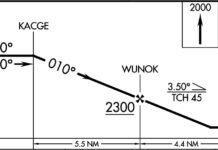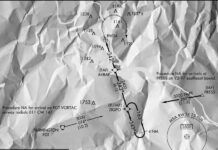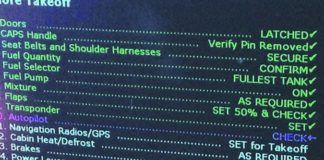Last month, we gave you a survey course on what happens behind the scenes of approach procedures (“TERPS 101”). That’s a prerequisite for this course, since we’re going to build on what was covered in that article to examine the nuts and bolts of other types of procedures. In case you didn’t complete the prerequisite, let’s quickly go over what you need to know.
Instrument procedures are developed according to a set of rules that guarantee an acceptable level of safety to pilots. These rules are colloquially known as TERPS, and provide, among other things, mathematical definitions of areas that must be evaluated for obstacles (known as Obstacle Evaluation Areas, or OEAs) and how much obstacle protection should be provided (known as Required Obstacle Clearance, or ROC) within those areas.
The application of ROC across an OEA is known as an Obstacle Clearance Surface (OCS), which is an imaginary surface that cannot be penetrated by obstacles. Depending on the area, the OCS can be flat or sloping. For a sloping OCS, the ROC varies with distance and is generally expressed as a slope ratio in terms of horizontal run over vertical rise (for example, 40:1 means for every 40 feet horizontally the height changes by one foot). Enough review. Ready?
Feeder/STAR/En-Route
From an obstacle clearance perspective, en-route areas (such as low altitude airways and routes), arrivals (STARs), and approach feeder segments are all handled the same. In the interest of simplicity, we’ll group all those different segments and procedures with the label “en-route segments.” For obstacles within en-route segments, a constant 1000 feet (2000 feet within Designated Mountainous Areas) of ROC is applied within the primary area.
Although the obstacle clearance requirements are the same, the OEA construction techniques for conventional en-route segments and RNAV en-route segments are quite different. RNAV en-route segments maintain a constant width of 4 NM from the centerline for primary areas with additional 2 NM secondary areas on each side. Feeder and STAR segments reduce to a constant 2 NM from the centerline for primary areas with 1 NM secondary areas when within 30 NM of the airport. However, several additional factors must be taken into consideration, resulting in more complex OEAs.
One consideration for conventional en-route segments is that aircraft overfly fixes, so aircraft making a large-magnitude turn can drift quite a bit before joining the outbound course. To account for this, conventional en-route OEAs provide additional protection on the outside of turns. Conventional en-route segments are also dependent upon the location of navaids used for the route, so the OEA takes into consideration the probable worst-case accuracy of the navaids (known as system accuracy).
The basic width of the conventional en-route segments is 4 NM from the centerline for primary areas with 2 NM secondary areas on each side. If the system accuracy lines exceed the basic width, the OEA follows the system accuracy lines (resulting in a bulge in the middle of the OEA). Normally, the pilot is expected to change navaids halfway along a route segment, but a changeover point can be other than halfway (perhaps to account for known navaid limitations), resulting in the zigzag symbol seen on your charts. This can also have a TERPS implication by potentially moving or introducing an OEA bulge due to the system accuracy lines.
Another evaluation performed for en-route segments (but not feeders or STAR routes) is the determination of minimum crossing altitudes (MCAs). The typical process for a pilot crossing an en-route fix to a higher MEA is to start climbing upon reaching the fix. TERPS requires that obstacle clearance be provided during this climb. If that surface is penetrated by an obstacle, a directional crossing altitude (MCA) will be published at the fix using an altitude that ensures that the climb will be protected. A pilot is expected to start climbing ahead of the MCA fix so it is crossed no lower than the specified altitude.
Departure Procedures
The most common type of obstacle departure procedure is known in the TERPS world as a diverse departure, which attempts to protect for turns in any direction after takeoff. Every IFR runway is evaluated for a diverse departure, which can result in permitting unrestricted departures with a standard climb gradient of 200 feet/NM, allowing departures with restrictions, or disallowing IFR departures altogether.
Since pilots are expected to climb straight ahead to a height of 400 feet above the departure runway before turning (unless a higher altitude is specified), the initial climb area (ICA) is a 40:1 sloping OCS from the surface at the end of the runway and protects for this initial climb off of the runway. (A required climb of 200 feet/NM is about 30:1, so the 40:1 OCS provides clearance.)
Conceptually, that 40:1 slope continues for 46 NM in designated mountainous areas or 25 NM otherwise to provide climb clearance beyond the ICA.
Any obstacle that penetrates the departure surfaces must be mitigated somehow; there are a couple of different techniques to do so, each with additional considerations for pilots. One common technique is to publish a climb gradient and termination altitude required to clear the penetrating obstacle. Thus, if a climb gradient applies to your departure, you won’t necessarily know where that obstacle is or whether it impacts your route of flight, but departures can sometimes be divided into sectors to make that a bit more sensible.
Another strategy to mitigate obstacle penetrations within a few miles of the end of the runway is to publish ceiling and visibility requirements to enable pilots to visually see and avoid the penetrating obstacle. Sometimes this option will be combined with a specified climb gradient to enable a close obstacle to be mitigated using ceiling and visibility, and a more distant obstacle to be mitigated with the climb gradient.
Since the departure OCS begins at the ground at the departure end of the runway, it often picks up obstacles close to the end of the runway as non-sensical penetrations. By non-sensical we mean the math indicating, for example, a 2500 feet/NM climb gradient for 10 feet to clear vegetation. To avoid these situations, obstacles that require a non-standard climb gradient to a height of 200 feet or less above the runway can be excluded from the evaluation. These are called low, close-in obstacles and are published with the departure procedure. While these obstacles are described textually (which limits their usefulness… a lot), it is expected that the pilot will visually avoid them during the departure.
Most ODPs are published textually, but some are published graphically and look a lot like a standard instrument departure (SID), with a subtle but significant difference between them.
ODPs (textual or graphical) are regulatory and will be published graphically as a human-factors consideration when the procedure is considered too complex to be clearly communicated textually (usually this means having more than one turn). SIDs are non-regulatory and are published primarily for air traffic efficiency reasons. You can tell that a departure procedure is a graphic ODP rather than a SID because it will have “(OBSTACLE)” included in its name.
The visual climb over airport (VCOA) departure is a different type of obstacle departure procedure in which aircraft depart and visually circle over the airport to a specified altitude and then proceed on course.
The VCOA evaluation begins with an area surrounding the departure airport, with a radius based on the expected true airspeed of departing aircraft (known as the visual climb area, or VCA). This is a simple cylinder of airspace. From there, a cone-shaped 40:1 sloping OCS projects up and out in all directions. If any obstacles penetrate this surface, the VCA is raised by the amount of penetration. Once the surface is clear, the published VCOA “climb to” altitude is based on the VCA height plus 250 feet of ROC.
Your TERPS May Vary
TERPS criteria, although complex, are ultimately based on clearly defined—at least for the most part—rules. It would be nice to think that all of the procedures out there uniformly follow this set of rules, but the reality is quite a bit messier. As with just about any attempt to apply a uniform set of rules to a large-scale population, exceptions are inevitable. In the case of TERPS, when procedure designers really want to do something that TERPS doesn’t allow (often due to airports or air traffic really wanting to do something), they can request a waiver for the applicable section of criteria.
The waiver request includes a justification that an equivalent level of safety is provided using other means and goes before a review board. If the waiver is approved (possibly with additional requirements), the procedure can still be published for use by the general public with no indications included on the procedure charts. In other cases, where a specific operator wants to do something for which TERPS criteria don’t exist, there are ways to develop special procedures to cover unique situations. Although less exotic, individual operators can also develop special procedures to airports or heliports (even private ones) that are fully compliant with criteria. In either case, the procedures will be restricted and only allowed to be used by those specific operators.
Another realistic consideration preventing the uniform application of criteria across all procedures is the sheer volume of procedures that could need to be modified when a rule is changed. The operating principle is that “old criteria aren’t bad criteria,” meaning that since a procedure complied with criteria when it was last updated, it’s still considered valid and safe (unless there were any changes considered to be safety critical). As a result, the TERPS criteria used to develop the procedures currently available for use varies widely.
When procedures receive a full amendment, they are brought up to the current TERPS criteria and this also resets the clock for its next periodic review (see sidebar). Full amendments are performed only when there’s a need for something significant to change on the procedure. For a procedure contained within airspace that hasn’t seen changes in a while, there can be quite a long time between full amendments. (We’ve found some current procedures that haven’t been amended in over 15 years.).




